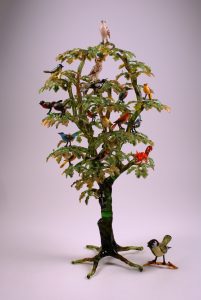Glas aus Thüringen: Eichbaum – Deutsch/German

Den Eichbaum mit Vögeln hat der Thüringer Arno Müller-Bauer um 1930 vor der Lampe gefertigt. Mit dem knorrigen Baumstamm aus grünen Farbglasstäben und den mit einer Zange geformten Blättern hat er das Charakteristische eines Eichbaums herausgearbeitet. Am meisten jedoch bestechen die aus einem Glasrohr geblasenen Vögel unterschiedlichster Art. Sie sind von solcher Naturtreue, dass man sie ohne weiteres identifizieren kann: Buntspecht, Bussard, Pirol, Rotkehlchen, Eule, Kohlmeise, Buchfink, Elster, Eisvogel, Kreuzschnabel und andere. 18 Stück sind es genau und ein Eichhörnchen.
Die ersten Glashütten im Thüringer Wald waren Klosterglashütten, die im 12. Jahrhundert vornehmlich Glasscheiben für Klöster und Kirchen herstellten. Im 14. Jahrhundert fertigten die Glasmacher in den Waldglashütten erste Gläser und Flaschen. Mit der Verlagerung der Hütten vom Wald ins Dorf und der Einführung der Lampenarbeit um 1770 entwickelte sich in Thüringen eine florierende Heimindustrie. Aus bunten Glasstäben und Glasröhren entstanden insbesondere Motive aus der Tierwelt. Diese wurden als Nippesfiguren in alle Teile der Welt exportiert.
Zentrum der Lampenglas- und Christbaumschmuckindustrie wurde Lauscha. Zeitgleich entstand in Ilmenau ein Zentrum für technisches und pharmazeutisches Glas. Gegen Ende des 19. Jahrhunderts entwickelte sich dann das Jenaer Glaswerk Schott & Genossen zum Weltkonzern für optisches und technisches Glas.
Bis zum Zweiten Weltkrieg hielten die Thüringer Laborglasbläser ihre Vormachtstellung. Dann verlagerte sich mit dem Flüchtlingsstrom aus Thüringen das Zentrum der Laborglasindustrie nach Wertheim.
Glass from Thuringia: Oak Tree – English

Arno Müller-Bauer from Thuringia completed the Oak tree with birds in around 1930 using a blowtorch. He captured the characteristics of the oak tree by using green glass rods for the gnarled tree trunk and shaping the leaves with pincers. The most captivating of all however are the different sorts of birds made using a glass blowers pipe. They are so true to nature that they can be recognised easily: the great spotted woodpecker, buzzard, oriole, robin, owl, great tit, common chaffinch, magpie, kingfisher, crossbill and others. There are 18 of them altogether and a squirrel.
The first glass foundries in the Thuringian Forest belonged to monasteries, which, during the 12th century, mainly produced panes of glass for monasteries and churches. During the 14th century the glassmakers in these forest foundries began making the first glasses and bottles. When these foundries were relocated from the forest into the villages and the blowtorch was introduced in around 1770, Thuringia developed into a flourishing „lampworking,“ home industry. Coloured glass rods and glass tubes were predominantly made into animal motifs, which were then exported all over the world as porcelain figurines.
Lauscha became the centre of the lamp work and Christmas tree decoration industry, while at the same time Ilmenau developed into a centre for technical and pharmaceutical glass. Towards the end of the 19th century Jenaer Scott & Associates Glassworks developed into a world concern for optical and technical glass.
The Thuringian laboratory glassblowers held their supremacy until the Second World War, but along with the flow of refugees out of Thuringia, the centre of the laboratory glass industry relocated to Wertheim.